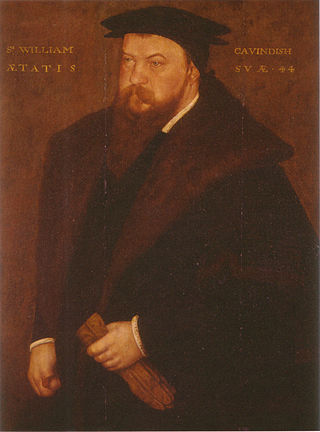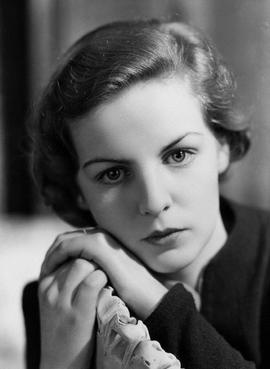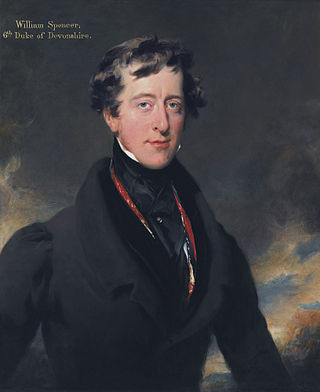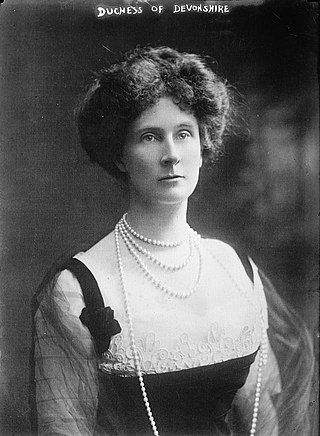
The Devonshire Arms is a moderately common name for an English pub. The name is for the Dukes of Devonshire, members of the peerage from a wealthy aristocratic family.

The Devonshire Arms is a moderately common name for an English pub. The name is for the Dukes of Devonshire, members of the peerage from a wealthy aristocratic family.
The name attributes the Duke (and often his wife the Duchess) of Devonshire, a peerage which is today the main peerage held by a Cavendish (the ducal titles of Portland and Newcastle being extinct). Wherever they held much land or contributed to a local vestry or other charity, as at Chatsworth, Derbyshire and in Chiswick, London (formerly Middlesex) are often Cavendish Arms – and later titular Devonshire Arms – pubs and street names [2]
At Chatsworth the pub name "The Snake" refers to the family's coat of arms; [3] as does the Snake Inn, a coaching inn on the old turnpike road on the Snake Pass in the Peak District of Derbyshire [4]
The Devonshire Arms in Kensington (37 Marloes Road) is a Victorian era pub built in 1865 with a traditional beer garden. It housed local ARP wardens during The Blitz.
The "Duke of Devonshire" in Balham High Road is a Victorian era corner pub with traditional pub glasswork from the late 1890s, included "an impressive, mirrored bar-back" with original counter and wooden panelling. [5]
The mock Tudor Devonshire Arms in Camden, also known as "The Dev" or by its previous name The Hobgoblin, is said to be "London's most famous alternative venue". [6] It was the first Goth subculture pub in Camden. It is the longest-surviving Goth pub in London and is a focus for the city's alternative scene. During the 1980s, Spider Stacy and Shane MacGowan of The Pogues frequented the pub. [7] The interior featured in "Goths", an episode from a 2003 BBC anthology series, Spine Chillers . [8]
The Devonshire Arms in Chiswick's Devonshire Road (also named for William Cavendish, 4th Duke of Devonshire [2] ) is a gastropub, formerly known as the Manor Tavern. The current building dates from 1924, but a pub already existed on the site in 1888. [9]
In Skipton, North Yorkshire, the three storey stone-built pub named for the Duke of Devonshire is known simply as "The Devonshire". It was once called "The New Inn". [10]
In Derbyshire, where the family has its great house at Chatsworth, there are Devonshire Arms pubs at Baslow, Beeley, and Pilsley, the last two both on the estate. [11] [12] [13]

Chatsworth House is a stately home in the Derbyshire Dales, 3.5 miles (5.6 km) north-east of Bakewell and 9 miles (14 km) west of Chesterfield, England. The seat of the Duke of Devonshire, it has belonged to the Cavendish family since 1549. It stands on the east bank of the River Derwent, across from hills between the Derwent and Wye valleys, amid parkland backed by wooded hills that rise to heather moorland. The house holds major collections of paintings, furniture, Old Master drawings, neoclassical sculptures and books. Chosen several times as Britain's favourite country house, it is a Grade I listed property from the 17th century, altered in the 18th and 19th centuries. In 2011–2012 it underwent a £14-million restoration. The owner is the Chatsworth House Trust, an independent charitable foundation, on behalf of the Cavendish family.

Sir William Cavendish MP was an English politician, knight and courtier. Cavendish held public office and accumulated a considerable fortune, and became one of Thomas Cromwell's "visitors of the monasteries" during the dissolution of the monasteries. He was MP for Thirsk in 1547. In 1547 he married Bess of Hardwick, and the couple began the construction of Chatsworth House in 1552, a project which would not be completed until after his death. His second son William Cavendish (1552–1626) became the first Earl of Devonshire, purchasing his title from the impecunious King James I.

Duke of Devonshire is a title in the Peerage of England held by members of the Cavendish family. This branch of the Cavendish family has been one of the wealthiest British aristocratic families since the 16th century and has been rivalled in political influence perhaps only by the Marquesses of Salisbury and the Earls of Derby.

Deborah Vivien Cavendish, Duchess of Devonshire, was an English aristocrat, writer, memoirist, and socialite. She was the youngest and last-surviving of the six Mitford sisters, who were prominent members of British society in the 1930s and 1940s.

William Cavendish, 3rd Duke of Devonshire, was a British nobleman and Whig politician who sat in the House of Commons from 1721 to 1729 when he inherited the Dukedom.

William George Spencer Cavendish, 6th Duke of Devonshire,, styled Marquess of Hartington until 1811, was a British peer, courtier, nobleman, and Whig politician. Known as the "Bachelor Duke", he was Lord Chamberlain of the Household between 1827 and 1828 and again between 1830 and 1834. The Cavendish banana is named after him.

Bakewell is a market town and civil parish in the Derbyshire Dales district of Derbyshire, England, known for Bakewell pudding. It lies on the River Wye, 13 miles (21 km) south-west of Sheffield. At the 2011 census, the population of the civil parish was 3,949. It was estimated at 3,695 in 2019. The town is close to the tourist attractions of Chatsworth House and Haddon Hall.

Baslow is a village in Derbyshire, England, in the Peak District, situated between Sheffield and Bakewell, just over 1 mile (1.6 km) north of Chatsworth House. It is sited by the River Derwent, which is spanned by a 17th-century bridge, alongside which is a contemporary toll house.
Peregrine Andrew Morny Cavendish, 12th Duke of Devonshire, is an English peer. He is the only surviving son of Andrew Cavendish, 11th Duke of Devonshire and his wife, the former Deborah Mitford. He succeeded to the dukedom following the death of his father on 3 May 2004. Before his succession, he was styled Earl of Burlington from birth until 1950 and Marquess of Hartington between 1950 and 2004. His immediate family are owner-occupiers of Chatsworth House and are worth an estimated £900 million. Estates landscaped before 1900 by the family are parts of Derbyshire and North Yorkshire. Other capital managed by the Duke includes fine and contemporary art, forestry and farming.

Mary Alice Cavendish, Duchess of Devonshire, was a British courtier who served as Mistress of the Robes to Queen Elizabeth II from 1953 to 1967. She was the granddaughter of Prime Minister Robert Gascoyne-Cecil, 3rd Marquess of Salisbury.

Evelyn Emily Mary Cavendish, Duchess of Devonshire, was the wife of Victor Cavendish, 9th Duke of Devonshire. She was the elder daughter of politician and diplomat Henry Petty-Fitzmaurice, 5th Marquess of Lansdowne and grew up amidst public life. Evelyn's marriage to Cavendish, nephew and heir presumptive of Spencer Cavendish, 8th Duke of Devonshire, led to her becoming Duchess of Devonshire in 1908. With her position, she oversaw the reorganisation of the Devonshire estates and presided over four English houses and one Irish castle.

Edensor is a village and civil parish in Derbyshire, England. The population of the civil parish at the 2011 census was 145.

Beeley is a village and civil parish in northern Derbyshire, England. Located near Bakewell in the Derbyshire Dales, it is situated on the B6012 road, between Rowsley and Edensor. The civil parish population at the 2011 Census was 195.

Baslow and Bubnell is a civil parish in the Derbyshire Dales district of Derbyshire in England. According to the 2001 census it had a population of 1,185, falling slightly to 1,178 at the 2011 Census. The parish is in the Peak District National Park and covers Baslow and Bubnell.

Pilsley is a small village and civil parish in Derbyshire, England. At the 2011 Census the population of the civil parish was 152. It is close to Chatsworth and most of it belongs to the Chatsworth House estate.

Chatsworth is a civil parish in Derbyshire, England, within the area of the Derbyshire Dales and the Peak District National Park.

White Watson was an early English geologist, sculptor, stonemason and carver, marble-worker and mineral dealer. In common with many learned people of his time, he was skilled in a number of artistic and scientific areas, becoming a writer, poet, journalist, teacher, botanist and gardener as well as a geologist and mineralogist. He kept extensive diaries and sketchbooks of his observations on geology, fossils and minerals, flora and fauna, and published a small but significant and influential number of geological papers and catalogues. As an artist he was well known locally for his silhouettes, both on paper and as marble inlays.

St Peter's Church, Edensor, is a Grade I listed church in Edensor, Derbyshire. St Peter's is the closest parish church in the Church of England to Chatsworth House, home of the Dukes of Devonshire, most of whom are buried in the churchyard. St Peter's is in a joint parish with St Anne's Church, Beeley.
Catherine Cavendish, Duchess of Devonshire, formerly Catherine Hoskins, was the wife of William Cavendish, 3rd Duke of Devonshire, and mother of the 4th Duke.

Gibbet Moor is a small gritstone upland area in the Derbyshire Peak District of central and northern England, near the village of Baslow. Its highest point is 295 metres (968 ft) above sea level. The Chatsworth Estate lies to the west and Umberley Brook run along its east edge. East Moor is the broader moorland area covering Gibbet Moor, Brampton East Moor and Beeley Moor. Gibbet Moor is a prehistoric landscape with several protected Scheduled Ancient Monuments.